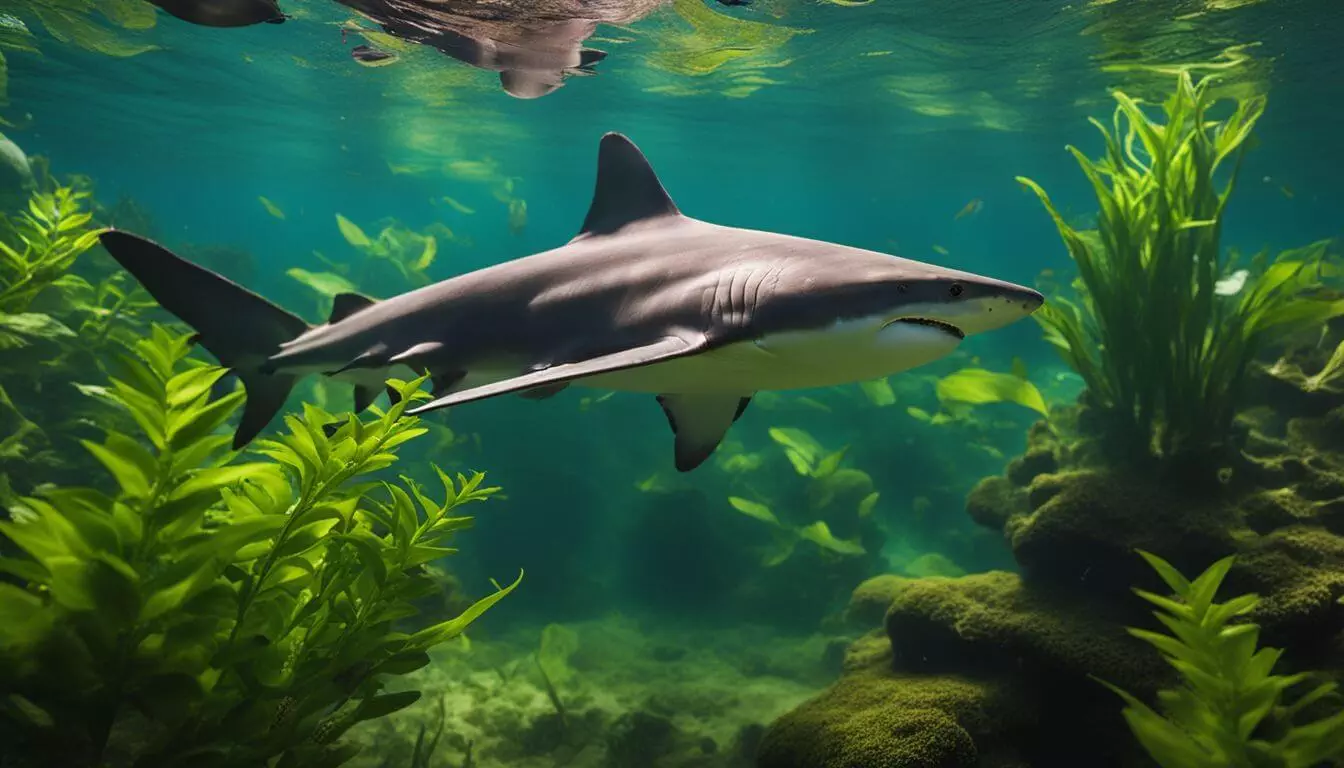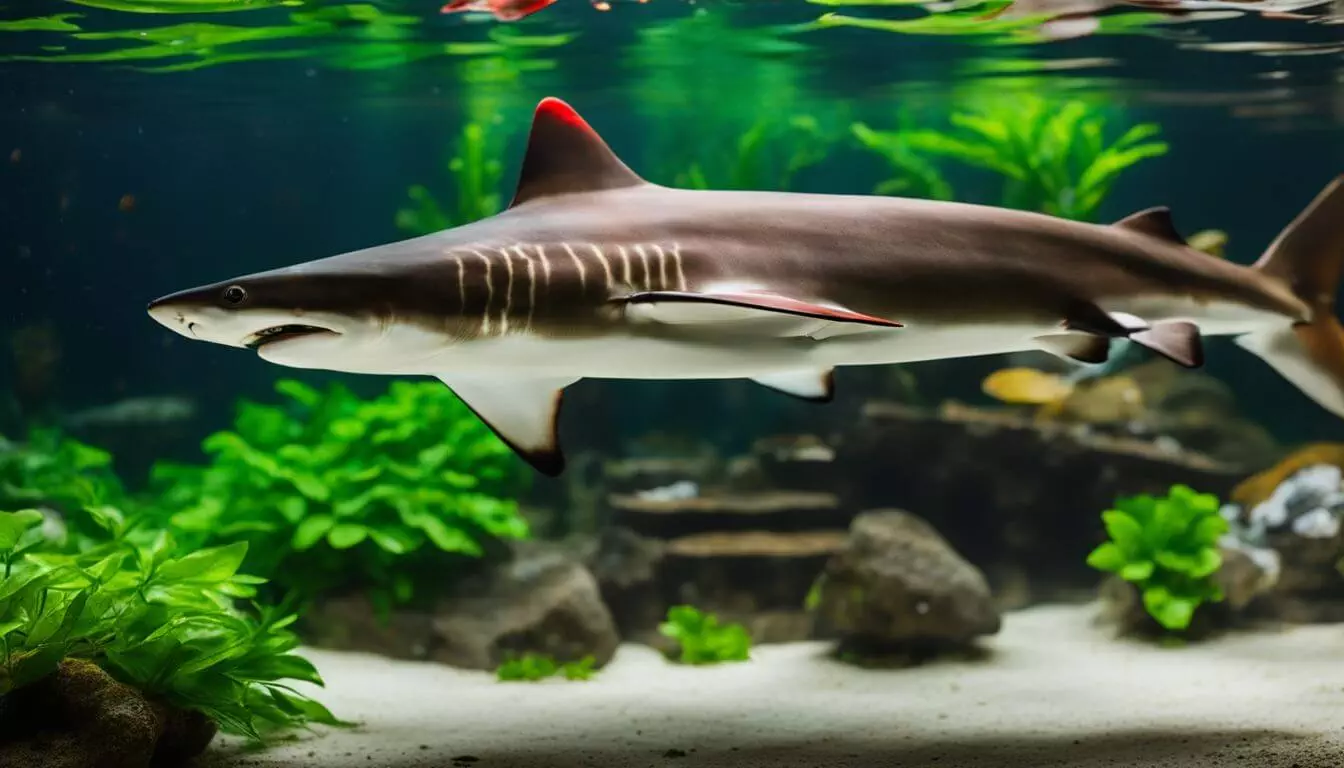As a passionate aquarist and experienced underwater photographer, I’ve spent years studying and caring for these beautiful fish. In this comprehensive guide, I’ll share my expertise on Red Tail Shark lifespan, care essentials, tank mate considerations, and more. The Red Tail Shark, commonly known for its striking red tail and sleek black body, is a popular choice for many fish enthusiasts. When it comes to choosing tank mates for this feisty species, it’s important to consider their territorial nature and potential aggression towards other fish. Additionally, understanding how goldfish lifespan varies can provide valuable insights into maintaining a healthy and thriving aquarium environment for all inhabitants. Through my years of hands-on experience, I’ve learned valuable tips and tricks that I’m excited to share with fellow aquarists.
You’ll learn how to optimize your tank setup, choose compatible tank mates, and provide the best care for your Red Tail Shark. Get ready to dive into the world of these fascinating freshwater fish and discover how to create a stunning aquarium that showcases their unique beauty.
Understanding the Red Tail Shark Lifespan in Home Aquariums

Understanding the Red Tail Shark lifespan in home aquariums is crucial for any aquarist considering adding this vibrant species to their tank. Red Tail Sharks, also known as red-tailed black sharks or fire tail sharks, can live an impressive 5 to 8 years with proper care.
As a member of the Cyprinidae family, they share similarities with other popular aquarium fish like barbs and rasboras. Providing a suitable environment and diet is key to helping your Red Tail Shark thrive and reach its full lifespan potential.
In my experience as an aquarium hobbyist and underwater photographer, I’ve found that maintaining stable water parameters, offering a varied diet, and creating a stress-free environment are essential for the longevity of Red Tail Sharks.
While they are critically endangered in their native habitat of Thailand, these striking fish with black bodies and bright red tail fins can flourish in a well-maintained tank. By understanding their lifespan and care requirements, you can create a thriving aquatic ecosystem that showcases the beauty of these semi-aggressive bottom-dwelling fish for years to come.
Red Tail Shark Care Essentials for a Thriving Aquarium

With an understanding of the Red Tail Shark’s lifespan potential, you can focus on providing the best care to ensure their longevity and well-being. Here are the essential elements for creating a thriving aquarium environment for your Red Tail Shark:
- Tank Size: Provide a minimum tank size of 55 gallons to accommodate your Red Tail Shark’s active swimming habits and territorial nature, allowing them ample space to establish their territory and reduce stress.
- Water Parameters: Maintain stable water conditions with a temperature range of 72°F to 79°F, pH levels between 6.5 and 7.5, and a water hardness of 10-15 KH to mimic their natural habitat and support their health.
- Filtration and Aeration: Install a robust filtration system to keep the tank clean and well-oxygenated, as Red Tail Sharks require pristine water quality to thrive, and consider adding an air stone or powerhead for additional aeration.
- Substrate and Decor: Create a natural-looking environment with a soft substrate like sand or fine gravel, and include hiding spots such as caves, driftwood, and plants to provide your Red Tail Shark with a sense of security and reduce territorial aggression.
- Tank Mates: Choose compatible tank mates that can coexist peacefully with your Red Tail Shark, such as larger, semi-aggressive fish species that occupy different levels of the tank and can hold their own against occasional chasing.
- Diet and Nutrition: Offer a varied diet consisting of high-quality flakes, pellets, algae, brine shrimp, small crustaceans, frozen foods, and vegetables to meet their omnivorous needs and support their vibrant coloration and overall health.
- Regular Maintenance: Perform frequent water changes, removing 10-15% of the tank water every week, to maintain optimal water quality, and regularly clean the substrate and decor to prevent the buildup of harmful waste and debris.
- Monitoring and Observation: Keep a close eye on your Red Tail Shark’s behavior, appetite, and physical appearance to quickly identify and address any signs of stress, illness, or aggression, ensuring prompt intervention when necessary.
The Social Dynamics of Red Tail Sharks: Tank Mates and Aggression
Now that you’ve mastered the essentials of Red Tail Shark care, it’s time to explore their social dynamics and tank mate compatibility. Red Tail Sharks are semi-aggressive and territorial, especially towards their own species.
They establish dominance and defend their territory, particularly the bottom of the tank. Keeping more than one Red Tail Shark in the same aquarium often leads to aggression and stress, compromising their well-being.
Choose tank mates wisely to create a harmonious underwater world for your Red Tail Shark.
When selecting tank mates for your Red Tail Shark, opt for robust, fast-moving fish that can hold their own. Ideal companions include larger cichlids, tiger barbs, giant danios, betta fish, Silver Dollars, Angelfish, Bala Sharks, Plecos, Cory Cats, and Swordtails.
As an experienced aquarist, I’ve found that these species can coexist peacefully with Red Tail Sharks, as long as the aquarium provides ample space and hiding spots. Steer clear of slow-moving or timid fish like goldfish, as they may become targets of the Red Tail Shark’s aggression.
Remember, a well-planned community tank is the key to a thriving aquatic ecosystem.
Red Tail Shark vs. Rainbow Shark: Tankmate Considerations and Lifespan
Red Tail Sharks and Rainbow Sharks share similarities, but their unique traits affect tank dynamics and lifespan. Consider these factors when choosing between them:
| Factor | Red Tail Shark | Rainbow Shark |
|---|---|---|
| Appearance | Black body with vibrant red tail | Silvery body with red fins |
| Size | Up to 6 inches | Up to 6 inches |
| Aggression Level | Semi-aggressive, territorial | Semi-aggressive, less territorial than Red Tails |
| Ideal Tank Mates | Top/middle-dwelling fish, cichlids, tiger barbs, giant danios, bettas | Similar to Red Tails, but more compatible with bottom-dwellers |
| Lifespan | 5-8 years with proper care | 5-8 years with proper care |
| Tank Size | Minimum 55 gallons | Minimum 55 gallons |
| Water Parameters | Temperature: 72-79°F, pH: 6.8-7.5, Hardness: 5-15 dGH | Temperature: 75-81°F, pH: 6.5-7.5, Hardness: 5-19 dGH |
Your aquarium’s size, inhabitants, and water chemistry guide your choice between these striking sharks. Proper care ensures a thriving ecosystem and a fulfilling 5-8 year journey with your finned friend.
Tank size and setup play a crucial role in creating the right environment for your Red Tail or Rainbow Shark to thrive.
Tank Size and Setup: Creating the Right Environment for Red Tail Sharks
Red Tail Sharks are active swimmers that need ample space to thrive. Setting up their aquarium correctly is crucial for their well-being and longevity.
- Tank Size: Opt for a minimum tank size of 55 gallons, as Red Tail Sharks require plenty of swimming space. A larger tank, such as a 75-gallon or 90-gallon aquarium, is ideal for providing them with a spacious and comfortable environment.
- Water Parameters: Maintain a water temperature between 72°F and 79°F, a pH range of 6.5 to 7.5, and a water hardness of 10-15 KH. Regularly test the water parameters using a reliable aquarium test kit to ensure they remain stable and suitable for your Red Tail Shark.
- Filtration: Install a robust filtration system that can handle the bioload of your aquarium. A canister filter or a combination of a hang-on-back filter and a sponge filter can help maintain excellent water quality, which is essential for the health of your Red Tail Shark and other tank inhabitants.
- Substrate: Use a soft, sandy substrate that mimics the river beds where Red Tail Sharks naturally inhabit. Avoid sharp or abrasive substrates that can damage their delicate barbels and fins. You can also add a few smooth river rocks or pebbles to create a natural-looking aquascape.
- Decorations and Hiding Spots: Provide plenty of hiding spaces for your Red Tail Shark, such as caves, driftwood, and rock formations. These decorations not only add visual interest to the aquarium but also help reduce stress and aggression by offering places for your shark to retreat and feel secure.
- Live Plants: Incorporate live aquatic plants into your Red Tail Shark’s tank to create a lush and natural environment. Plants like Java Fern, Anubias, and Amazon Sword are excellent choices, as they can tolerate the active swimming habits of Red Tail Sharks and provide them with additional hiding spots.
- Lighting: Use a suitable aquarium light fixture that promotes the growth of live plants and mimics a natural day-night cycle. Avoid excessively bright lighting, as Red Tail Sharks prefer a slightly dim environment that resembles their native habitat.
- Water Flow: Create a moderate water flow in the aquarium using a powerhead or an adjustable output filter. Red Tail Sharks appreciate a gentle current that simulates the flowing waters of their natural habitat. However, avoid excessively strong currents that can stress or exhaust your shark.
Caring for Your Red Tail Shark: Maintenance and Monitoring
With a proper tank setup, you’ve created a foundation for your Red Tail Shark to thrive. Consistent maintenance and monitoring will ensure your shark remains healthy and your aquarium stays balanced.
- Perform regular water changes: Conduct partial water changes of 10-20% every 1-2 weeks to maintain good water quality. Use a gravel vacuum to remove debris and waste from the substrate during water changes.
- Monitor water parameters: Regularly test the water for ammonia, nitrite, nitrate, pH, and hardness levels using a reliable aquarium test kit. Red Tail Sharks prefer slightly alkaline water with a pH between 7.0 and 7.5, and a temperature range of 72-79°F (22-26°C).
- Maintain filtration: Clean or replace filter media as needed to ensure efficient filtration and maintain beneficial bacteria populations. A well-functioning filter helps keep the water clean and oxygenated.
- Provide a balanced diet: Feed your Red Tail Shark a varied diet consisting of high-quality flakes, pellets, and occasional live or frozen foods like brine shrimp, bloodworms, and daphnia. Offer small portions 2-3 times daily, and remove any uneaten food to prevent water pollution.
- Observe behavior and appearance: Regularly observe your Red Tail Shark’s behavior, swimming patterns, and physical appearance. Watch for signs of stress, aggression, or disease, such as lethargy, loss of appetite, torn fins, or white spots on the body.
- Trim and maintain live plants: If you have a planted tank, regularly trim and maintain the vegetation to prevent overgrowth and ensure adequate swimming space for your Red Tail Shark and other fish.
- Quarantine new fish: When introducing new fish to the tank, always quarantine them in a separate aquarium for 2-4 weeks to prevent the spread of potential diseases to your Red Tail Shark and existing tank mates.
- Address health issues promptly: If you notice any signs of illness or disease in your Red Tail Shark or other fish, take immediate action by isolating the affected fish, researching the symptoms, and providing appropriate treatment under the guidance of a veterinarian or experienced aquarist.
Conclusion
Cherish the journey of caring for your Red Tail Shark. These enchanting creatures, with the right care and environment, can become the centerpiece of your aquarium, creating a serene underwater world for years to come.
Let this guide be your roadmap to aquarium success. With a lifespan of up to 8 years, you’ll have ample time to enjoy their striking appearance and lively personality. Provide them with a spacious tank, suitable tank mates, and a well-maintained habitat, and watch as they thrive under your care.
FAQs
1. How long do red tail sharks live?
Red tail sharks can live up to 8 years or more with proper care in the right tank environment. Provide them with a well-maintained, spacious tank and a balanced diet to ensure their longevity.
2. What size tank do red tail sharks need?
Red tail sharks need a tank of at least 55 gallons, as they are active fish that require ample swimming space. A bigger tank, such as a 75-gallon or larger, is ideal for providing them with a comfortable home.
3. Can I keep more than one red tail shark in my tank?
It’s best to keep only one red tail shark per tank, as they can be aggressive towards other fish, especially those of their own species. If you want to keep multiple sharks, you’ll need a very large tank with plenty of hiding spots.
4. What are good tank mates for red tail sharks?
Good tank mates for red tail sharks include peaceful, fast-moving fish that can coexist with their active nature. Some options are barbs, danios, rainbowfish, and larger tetras. Avoid slow-moving or long-finned fish that may be targeted by the shark.
5. What do red tail sharks eat?
Red tail sharks are omnivores and require a varied diet. Offer them a mix of high-quality flake or pellet food, along with occasional treats of live or frozen foods like brine shrimp, bloodworms, and daphnia. Supplement their diet with blanched vegetables such as spinach or zucchini.
6. How can I create the ideal tank environment for my red tail shark?
To create the perfect home for your red tail shark, provide a spacious tank with a sandy or fine gravel substrate, plenty of hiding spots like caves and driftwood, and a strong filtration system. Maintain stable water parameters and perform regular water changes to keep your shark healthy and thriving.





